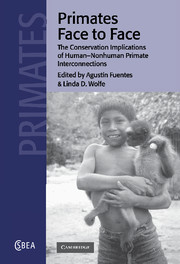Book contents
- Frontmatter
- Contents
- List of contributors
- Foreword
- Acknowledgements
- Introduction
- Part 1 Science and nonhuman primates
- Part 2 Cultural views of nonhuman primates
- 4 Monkey as food, monkey as child: Guajá symbolic cannibalism
- 5 Ethnoecology of monkeys among the Barí of Venezuela: perception, use and conservation
- 6 Primates in Matsigenka subsistence and world view
- 7 Monkey King in China: basis for a conservation policy?
- 8 Reflections on the concept of nature and gorillas in Rwanda: implications for conservation
- Part 3 Conservation of nonhuman primates
- Part 4 Government actions, local economies and nonhuman primates
- Index
4 - Monkey as food, monkey as child: Guajá symbolic cannibalism
Published online by Cambridge University Press: 20 October 2009
- Frontmatter
- Contents
- List of contributors
- Foreword
- Acknowledgements
- Introduction
- Part 1 Science and nonhuman primates
- Part 2 Cultural views of nonhuman primates
- 4 Monkey as food, monkey as child: Guajá symbolic cannibalism
- 5 Ethnoecology of monkeys among the Barí of Venezuela: perception, use and conservation
- 6 Primates in Matsigenka subsistence and world view
- 7 Monkey King in China: basis for a conservation policy?
- 8 Reflections on the concept of nature and gorillas in Rwanda: implications for conservation
- Part 3 Conservation of nonhuman primates
- Part 4 Government actions, local economies and nonhuman primates
- Index
Summary
Human ecology and primate ecology share a concern with the relationship of primates to the environment, yet they have been segregated into treatment of human primates in cultural anthropology and nonhuman primates in biological anthropology. Although observational techniques from primate ethology have been adapted for use in human ethnography, and primate studies have treated interspecific primate relations, neither has attempted to integrate such research concerns. Sponsel (1997) was the first to systematically address the problem in his call for the development of a field of inquiry called ‘ethnoprimatology’, which would explore the interface of human ecology and primate ecology through comparative ecology, predation ecology, symbiotic ecology, cultural ecology, ethnoecology and conservation ecology.
The Guajá Indians provided an ideal opportunity to apply ethnoprimatology, as local primates are central to the Guajá way of life in material, social, and ideological aspects of their culture. The Guajá are a Tupi–Guarani-speaking group located in the high terra firme forest of western Maranhão, Brazil, on the eastern border of Amazonia proper. Although traditionally living in small foraging bands of five to fifteen people, most have been incorporated to varying degrees into one of three villages established after 1973 by the FUNAI (the Brazilian Indian agency) and are learning to cultivate domesticated plants (Balée, 1988; Gomes, 1996).
- Type
- Chapter
- Information
- Primates Face to FaceThe Conservation Implications of Human-nonhuman Primate Interconnections, pp. 63 - 84Publisher: Cambridge University PressPrint publication year: 2002
- 23
- Cited by



